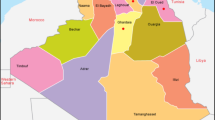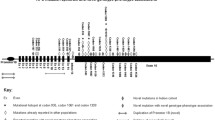Abstract
Background
Colorectal polyp burden is crucial for the management of patients with familial adenomatous polyposis (FAP). However, accurate evaluation of polyp burden is difficult to standardize. This study aimed to examine the possible utility of genotype-oriented management of colorectal neoplasms in patients with FAP.
Methods
Clinicopathological data from genetically proven patients with FAP was analyzed using the database of a nationwide retrospective Japanese multicenter study. The cumulative incidence of CRC was evaluated between different genotype groups. Genotype-1 were defined as germline variants on attenuated FAP-associated regions (codons 1–177, alternative splice site of exon 10 (codon 312), 1581–2843) and Genotype-2 as the other variants. Weibull and Joinpoint analyses were performed to determine the annual percentage changes in CRC risk.
Results
Overall, 69 men and 102 women were included. Forty-eight patients underwent colorectal resection for the first CRC, and five patients underwent resection for first cancer in the remnant anorectal segment after prophylactic surgery. The 70-year cumulative incidence of CRC in all patients was 59.3%. Patients with Genotype-1 (n = 23) demonstrated a lower risk of CRC stages II–IV than those with Genotype-2 (n = 148, P = 0.04). The risk of stage II–IV CRC was estimated to increase markedly at the age of 49 years in the Genotype-1 patients and 34 years in the Genotype-2 patients, respectively.
Conclusions
Different interventional strategies based on genotypes may be proposed for the clinical management of patients with FAP. This policy needs to be validated in further prospective studies focusing on long-term endoscopic intervention and optimal age at prophylactic (procto)colectomy.





Similar content being viewed by others
References
Yen T, Stanich PP, Axell L et al (2022) APC-associated polyposis conditions. 1998 Dec 18. GeneReviews® [Internet]. In: Adam MP, Mirzaa GM, Pagon RA, Wallace SE, Bean LJH, Gripp KW, Amemiya A, editors. University of Washington, Seattle, pp 1993–2022
Tomita N, Ishida H, Tanakaya K et al (2021) Japanese Society for Cancer of the Colon and Rectum (JSCCR) guidelines 2020 for the Clinical Practice of Hereditary Colorectal Cancer. Int J Clin Oncol 26:1353–1419
Mori Y, Amano K, Chikatani K et al (2022) Recent trends in the morbidity and mortality in patients with familial adenomatous polyposis: a retrospective single institutional study in Japan. Int J Clin Oncol 27:1034–1042
Ishikawa H, Mutoh M, Iwama T et al (2016) Endoscopic management of familial adenomatous polyposis in patients refusing colectomy. Endoscopy 48:51–55
Matsubara T, Beppu N, Ikeda M et al (2022) Current clinical practice for familial adenomatous polyposis in Japan: a nationwide multicenter study. Ann Gastroenterol Surg 6:778–787
Vasen HFA, Ghorbanoghli Z, de Ruijter B et al (2019) Optimizing the timing of colorectal surgery in patients with familial adenomatous polyposis in clinical practice. Scand J Gastroenterol 54:733–739
Lynch PM, Morris JS, Wen S et al (2016) A proposed staging system and stage-specific interventions for familial adenomatous polyposis. Gastrointest Endosc 84:115-125.e4
Campos FG (2014) Surgical treatment of familial adenomatous polyposis: dilemmas and current recommendations. World J Gastroenterol 20:16620–16629
Kartheuser A, Stangherlin P, Brandt D et al (2006) Restorative proctocolectomy and ileal pouch-anal anastomosis for familial adenomatous polyposis revisited. Fam Cancer 5:241–260
Wallace MH, Frayling IM, Clark SK et al (1999) Attenuated adenomatous polyposis coli: the role of ascertainment bias through failure to dye-spray at colonoscopy. Dis Colon Rectum 42:1078–1080
Young J, Simms LA, Tarish J et al (1998) A family with attenuated familial adenomatous polyposis due to a mutation in the alternatively spliced region of APC exon 9. Hum Mutat 11:450–455
Cheah PY, Wong YH, Koh PK et al (2014) A novel indel in exon 9 of APC upregulates a ‘skip exon 9’ isoform and causes very severe familial adenomatous polyposis. Eur J Hum Genet 22:833–836
Su LK, Barnes CJ, Yao W et al (2000) Inactivation of germline mutant APC alleles by attenuated somatic mutations: a molecular genetic mechanism for attenuated familial adenomatous polyposis. Am J Hum Genet 67:582–590
Jansen AML, Goel A (2020) Mosaicism in patients with colorectal cancer or polyposis syndromes: a systematic review. Clin Gastroenterol Hepatol 18:1949–1960
Takao M, Yamaguchi T, Eguchi H et al (2021) APC germline variant analysis in the adenomatous polyposis phenotype in Japanese patients. Int J Clin Oncol 26:1661–1670
Richards S, Aziz N, Bale S et al (2015) Standards and guidelines for the interpretation of sequence variants: a joint consensus recommendation of the American College of Medical Genetics and Genomics and the Association for Molecular Pathology. Genet Med 17:405–424
James DB (editor) (2016) M.K.G.E. In: Wittekind C editor, TNM classification of malignant tumours, 8th ed. Willey, Oxford
Sieber OM, Segditsas S, Knudsen AL et al (2006) Disease severity and genetic pathways in attenuated familial adenomatous polyposis vary greatly but depend on the site of the germline mutation. Gut 55:1440–1448
Kim HJ, Fay MP, Feuer EJ et al (2000) Permutation tests for joinpoint regression with applications to cancer rates. Stat Med 19:335–351
Iwama T, Mishima Y, Utsunomiya J (1993) The impact of familial adenomatous polyposis on the tumorigenesis and mortality at the several organs. Its rational treatment. Ann Surg 217:101–108
Iwama T, Tamura K, Morita T et al (2004) A clinical overview of familial adenomatous polyposis derived from the database of the polyposis registry of Japan. Int J Clin Oncol 9:308–316
Hanson CA, Miller JR (2005) Non-traditional roles for the adenomatous polyposis coli (APC) tumor suppressor protein. Gene 361:1–12
Spirio L, Olschwang S, Groden J et al (1993) Alleles of the APC gene: an attenuated form of familial polyposis. Cell 75:951–957
Sulekova Z, Reina-Sanchez J, Ballhausen WG (1995) Multiple APC messenger RNA isoforms encoding exon 15 short open reading frames are expressed in the context of a novel exon 10A-derived sequence. Int J Cancer 63:435–441
Rozen P, Samuel Z, Shomrat R et al (1999) Notable intrafamilial phenotypic variability in a kindred with familial adenomatous polyposis and an APC mutation in exon 9. Gut 45:829–833
Ishikawa H, Yamada M, Sato Y et al (2022) Intensive endoscopic resection for downstaging of polyp burden in patients with familial adenomatous polyposis (J-FAPP Study III): a multicenter prospective interventional study. Endoscopy. https://doi.org/10.1055/a-1945-9120
Acknowledgements
We would like to express our gratitude to Dr. Takeo Iwama and Dr. Kazushige Kawai for their useful advice.
Funding
The authors did not received support from any organization for the submitted work.
Author information
Authors and Affiliations
Contributions
HI, AC, NT, AT, KS, KA, KT, TN, and YA designed and conceptualized the study. YM, NC, TI, KA, KC, YT, MK, SS, MT, and SN collected data. YM, HI, and TY analyzed the data. HI, YM, and TY interpreted data and drafted the manuscript. TY, YM, and HI revised the APC variants. All the authors have read and approved the final manuscript.
Corresponding author
Ethics declarations
Conflict of interest
The authors have no conflict of interest to declare.
Additional information
Publisher's Note
Springer Nature remains neutral with regard to jurisdictional claims in published maps and institutional affiliations.
Supplementary Information
Below is the link to the electronic supplementary material.
About this article
Cite this article
Mori, Y., Ishida, H., Chika, N. et al. Usefulness of genotyping APC gene for individualizing management of patients with familial adenomatous polyposis. Int J Clin Oncol 28, 1641–1650 (2023). https://doi.org/10.1007/s10147-023-02419-6
Received:
Accepted:
Published:
Issue Date:
DOI: https://doi.org/10.1007/s10147-023-02419-6




